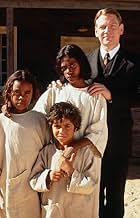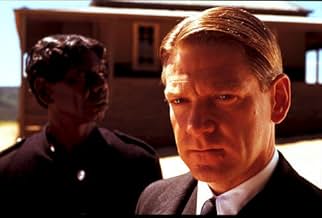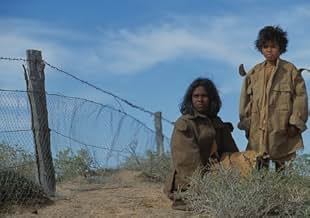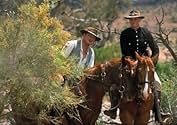In 1931, three half-white, half-Aboriginal girls escape after being plucked from their houses to be trained as domestic staff, and set off on a journey across the Outback.In 1931, three half-white, half-Aboriginal girls escape after being plucked from their houses to be trained as domestic staff, and set off on a journey across the Outback.In 1931, three half-white, half-Aboriginal girls escape after being plucked from their houses to be trained as domestic staff, and set off on a journey across the Outback.
- Awards
- 23 wins & 25 nominations
Lorna Lesley
- Miss Thomas
- (as Lorna Leslie)
- Director
- Writers
- All cast & crew
- Production, box office & more at IMDbPro
Storyline
Did you know
- TriviaEverlyn Sampi (Molly Craig) ran away twice during filming. In one instance, she was found in a phone booth, trying to buy tickets back to Broome.
- GoofsThe three girls Molly, Gracie and Daisy were not taken by surprise and removed by force from Jigalong. The violent removal scene in the film is entirely fictional. The girls' mothers were informed beforehand they were to travel with Constable Riggs and, without any protest, they acquiesced in the decision. The girls left Jigalong on horseback, not locked in a motor car.
- Quotes
Daisy Kadibill: [after Molly lifts Daisy up to a bird's nest to gather some eggs to eat] Three of them!
Molly Craig: Perfect. One for you, one for me, and one for both of us!
- Crazy creditsThe painting songs sung by the Walpiri, Amatjere and Wangajunka women were not sacred songs, but were songs able to be performed in public.
- ConnectionsEdited from A Steam Train Passes (1974)
- SoundtracksNgankarrparni
(Sky Blue Reprise) (2002)
Written by Peter Gabriel
Featured by The Blind Boys of Alabama, Myarn Lawford (as Myarn) and Ningali Lawford
Featured review
This powerful film follows the journey of three young aboriginal girls who are taken from their family and forced to assimilate into an empty culture by the white settlers of Australia. This is known as the "STOLEN GENERATION", a dark period in Australian history which the current prime minister of Australia refuses to say sorry for the past atrocities. But this is not to say that this film preaches or manipulates emotions for political gain. No! It just tells the story with powerful images that allows the viewer to enter the torment of the stolen generation. Dialogue is minimal as our heroes are taken from their family and driven to the other side of Australia. But their will and instinct to be with their strong culture has the girls escape the camp prison and follow the rabbit-proof fence back home. The rabbit proof fence was built down the centre of Australia to contain the plague of rabbits from entering farm land. It was this white-man built fence that lead the girls back home.
As for all journeys, they are filled with internal conflict and confrontations with strangers. These confrontations with certain people show the diverse group of settlers in Australia. Not all were ignorant but most were repressed and abided to the harsh cultured laws. For instance, the girls arrive at a farmstead and are given clothing and food by a white woman. The motherly instinct of this woman understood that the girls had to be with their mothers. But at the same token the farm woman could not jeopardise her own family by looking after the girls or else it would have brought trouble. It was wonderful scenes like these that was played out visually without having to dumb it down with words. As human beings we understand these actions and need no explaining.
The most interesting relationship was the one between the aboriginal tracker in search of the girls. He could sense the persistence of these girls to get home by making it difficult for him to track them down. This he respected and slightly dropped his guard. Once again, a string of images tell of this distant relationship between tracker and girls.
The images also became so strong during the scene when the girls were taken from their mothers in a horrific manner. I doubt there will be a dry eye during that scene. This hooks you in as you then become the spirit of their journey back home.
Only by the performances of the girls do these scenes work because they are so natural and heartfelt. Children who overplay their role just become cute but those who underplay and rely on emotions of the situation deliver a powerhouse performance that a trained actor may sometimes find difficult to achieve. At first the name of a high calibre actor - such as Kenneth Branagh - in an Australian film warns you where the limelight will shine. But Kenneth just took a step back and become another important confrontational figure in the journey.
A bonus is the music by Peter Gabriel. It is a mixture of his famous trademark of world music infused with that of the Aboriginal. It soars and plays with the emotions, maybe a little too much but when you are dealing with a thousand year old culture that has music as its central universe, then you may be able to understand that the overpowerful music is just an extension of that.
Congratulations to all who were brave enough to bring a project of this strength to the screen. And for those who may wonder how I saw the film prior to its release, lets just say I was lucky enough to be at the right place at the right time. And No! I'm not tied to the project in any way because I don't sell out that easily.
As for all journeys, they are filled with internal conflict and confrontations with strangers. These confrontations with certain people show the diverse group of settlers in Australia. Not all were ignorant but most were repressed and abided to the harsh cultured laws. For instance, the girls arrive at a farmstead and are given clothing and food by a white woman. The motherly instinct of this woman understood that the girls had to be with their mothers. But at the same token the farm woman could not jeopardise her own family by looking after the girls or else it would have brought trouble. It was wonderful scenes like these that was played out visually without having to dumb it down with words. As human beings we understand these actions and need no explaining.
The most interesting relationship was the one between the aboriginal tracker in search of the girls. He could sense the persistence of these girls to get home by making it difficult for him to track them down. This he respected and slightly dropped his guard. Once again, a string of images tell of this distant relationship between tracker and girls.
The images also became so strong during the scene when the girls were taken from their mothers in a horrific manner. I doubt there will be a dry eye during that scene. This hooks you in as you then become the spirit of their journey back home.
Only by the performances of the girls do these scenes work because they are so natural and heartfelt. Children who overplay their role just become cute but those who underplay and rely on emotions of the situation deliver a powerhouse performance that a trained actor may sometimes find difficult to achieve. At first the name of a high calibre actor - such as Kenneth Branagh - in an Australian film warns you where the limelight will shine. But Kenneth just took a step back and become another important confrontational figure in the journey.
A bonus is the music by Peter Gabriel. It is a mixture of his famous trademark of world music infused with that of the Aboriginal. It soars and plays with the emotions, maybe a little too much but when you are dealing with a thousand year old culture that has music as its central universe, then you may be able to understand that the overpowerful music is just an extension of that.
Congratulations to all who were brave enough to bring a project of this strength to the screen. And for those who may wonder how I saw the film prior to its release, lets just say I was lucky enough to be at the right place at the right time. And No! I'm not tied to the project in any way because I don't sell out that easily.
- How long is Rabbit-Proof Fence?Powered by Alexa
Details
- Release date
- Country of origin
- Official site
- Languages
- Also known as
- Rabbit Proof Fence
- Filming locations
- Production companies
- See more company credits at IMDbPro
Box office
- Budget
- $6,000,000 (estimated)
- Gross US & Canada
- $6,199,600
- Opening weekend US & Canada
- $88,352
- Dec 1, 2002
- Gross worldwide
- $16,220,968
- Runtime1 hour 34 minutes
- Color
- Sound mix
- Aspect ratio
- 2.35 : 1
Contribute to this page
Suggest an edit or add missing content
































